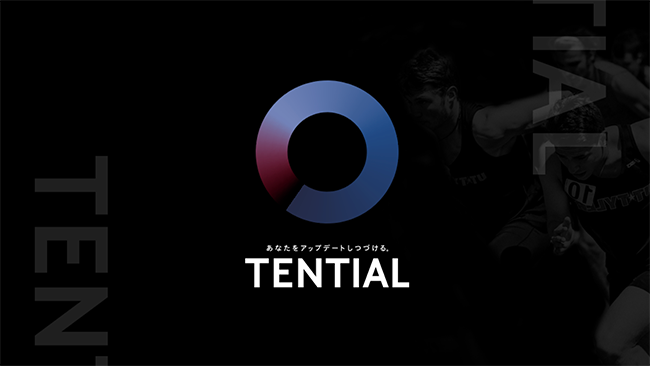Note: This website was automatically translated, so some terms or nuances may not be completely accurate.
What is the "design before design" that startups need first?
" TANTEKI " is a service that designs new technologies and service ideas, particularly from startups, into "communicative forms."
This time, I, Taichi Sayama, will share what's crucial for startups when tackling so-called "design," from an art director's perspective.
【Table of Contents】
▼ Focus on "What and Why to Design" Over "What Kind of Design"
▼ Bridging the Gap Between Message and Reality is Design's Role
▼ Three Design Examples That Transformed "What We Want to Communicate" into "A Form That Communicates Effectively"
▼ Summary: What Matters is Defining Design's Function
Think about "what to design and why" rather than "what the design looks like"

Truth is, design is a major hurdle for startups.
TANTEKI often gets requests like "Our website looks uncool, we need to fix it" or "We want a cool logo." But why does "uncool design" happen in the first place?
To put it simply, the cause falls into one of two categories:
- The message isn't clearly defined
- You have something to convey, but it's not connected to the design
Discussing "What kind of design should we make?" in this state only leads to abstract discussions about aesthetics and wastes time.
At TANTEKI, before asking "What kind of design should we create?", we first define the design's function: "Why are we designing this?" and "What should we design to achieve that purpose?"
For fast-paced startups, defining function is more important than the precision of the image. Even if something looks polished at first glance, having vague art with unclear purpose can become a hindrance. The design must have a clear, practical function for immediate business use and communication.
So, how do we define this function? Before explaining that, let's look at the overall picture of TANTEKI's services.
●The Overall Structure of TANTEKI's Services for Startups
TANTEKI's service is broadly structured in three steps: "Scope," "Message," and "Design."
・Step ① "Scope"
First, we identify the communication goal: "Whose feelings or actions do we want to change, and how?" and "What aspects of our company need to be communicated to achieve this?"
・Step 2: "Message"
Based on the scope, we develop messages and statements that overcome audience indifference—reactions like "This doesn't concern me" or "Who cares?" In essence, this is copywriting. For details, please refer to our past series.
・Step 3: "Design"
To convey your message clearly, it's effective to use communication tools beyond just words—like logos, characters, UI, and visuals. Don't settle for something that's just "kind of cool."
At TANTEKI, we execute these three steps at breakneck speed—within one to one and a half months—using a compact team structure: business owner, copywriter, and art director. This approach prevents situations where "the ball gets passed around to various people, turning into a game of telephone."
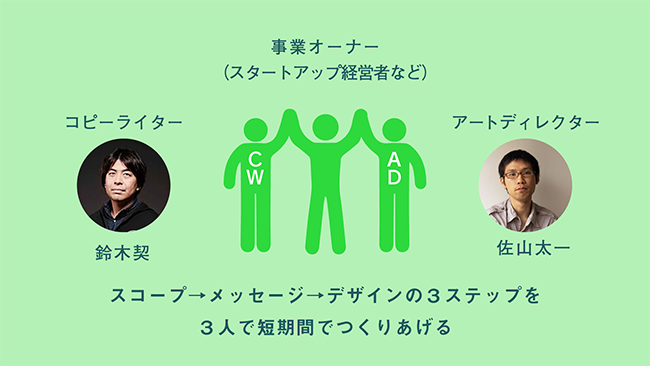
After repeated discussions among the three parties, once a somewhat vague consensus forms ("Could this be it?") – defining the scope – we then sharpen and clarify that hazy concept into a high-resolution message and design.
In other words, as we define the scope and solidify the message, the functional definition of the design becomes clear.
The role of design is to bridge the gap between message and reality.
When refining the functional definition of design, I always observe the gap between a startup's "message" and its "reality," and consider how to bridge that gap.
The "message" represents the startup's vision or the business owner's challenges. However, in many cases, the "reality" of the business hasn't yet caught up with the message. That's where design steps in to fill the gap.
Conversely, if the "message" alone cannot fully convey the "reality," I propose communication tools to supplement those aspects.
Three Design Examples: Transforming "What We Want to Communicate" into "A Form That Gets Through"
Here are three concrete examples of TANTEKI where we defined design functions to bridge gaps.
● Case 1
TRANBI: Business Succession & M&A Platform
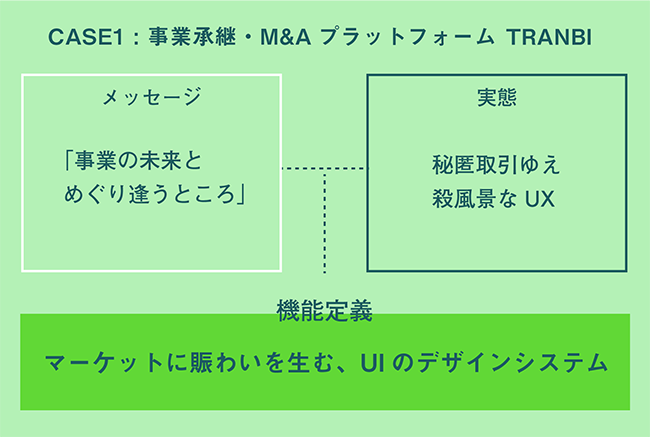
TRANBI is Japan's largest "business succession and M&A platform" for buying and selling businesses.
First, we discussed with business owners, "What exactly is this platform?"
and defined its message as:
This is the message we defined.
However, since M&A transactions are confidential by nature, we cannot publish detailed business information on the website. Consequently, the initial UI/UX featured only numerical data like sales figures and accompanying descriptions.
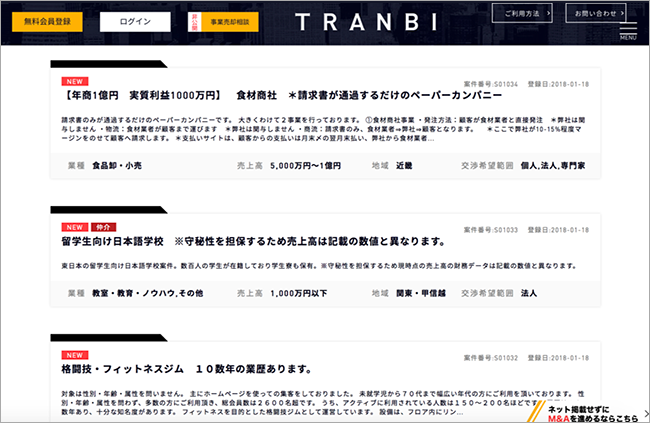
Despite promoting the positive message of "encounters," the actual UX was stark. Sensing this gap, I proposed a UI design system that would inject vibrancy into the marketplace.
By observing the gap between the "message" and the "reality," I supplemented the missing elements with icons and meta-information. Implementing this UI made the diversity of the projects immediately apparent and gave the message greater persuasiveness.
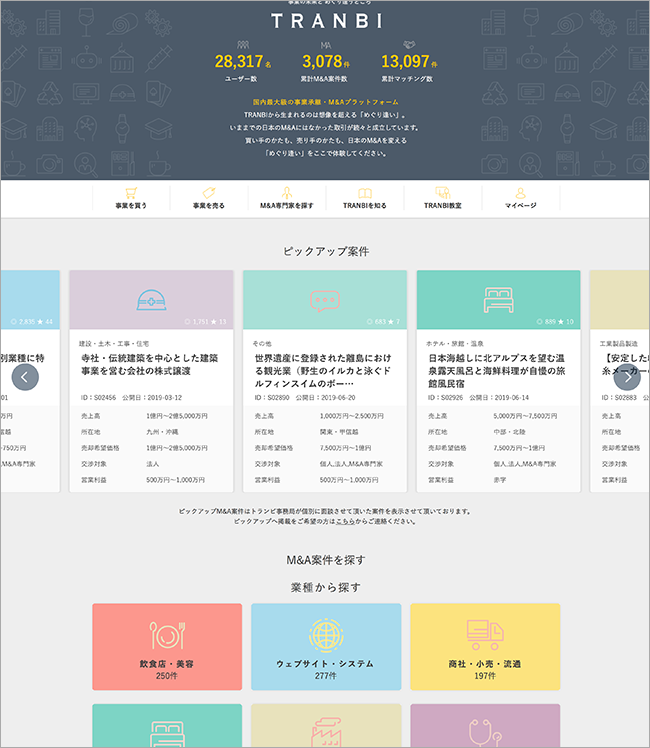
●Case 2
Platelet Manufacturing Technology: Adiposeeds
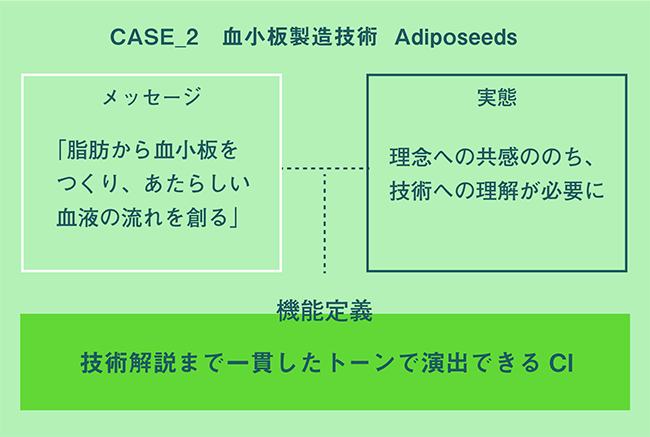
Adiposeeds possesses technology to produce platelets not from iPS cells, but from so-called mesenchymal stem cells. Therefore,
creating platelets from fat to establish new blood flow
(see previous article ).
To resonate with the message highlighting the difference from iPS cells, I felt it was essential to make the actual technology compelling—that is, to communicate the technology clearly and thoroughly.
Therefore, we prioritized a CI (Corporate Identity) that could be consistently applied to the technical explanations. It wasn't just a logo; we designed the CI and created a full set of icons for explaining the technology, enabling us to "use the CI to explain the cell differentiation process."

●Case 3
The case of sports brand TENTIAL
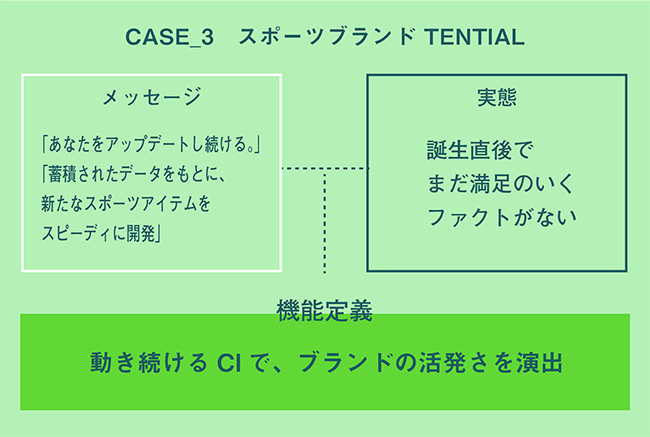
TENTIAL is a Direct-to-Consumer (DTC) sports brand.
It aims to be a new type of brand, such as measuring foot size and pressure points to recommend suitable items, or developing new sports products based on accumulated data.
The message they want to convey is:
to keep you updated
and rapidly develop new sports items based on accumulated data.
These two points. In other words, the concept was not to keep making fixed products, but for the brand itself to actively keep changing.
However, since the brand had just launched, there were no products to feature on the website. This meant we needed to supplement the message with tangible substance.
Therefore, we used a continuously moving CI, inspired by a progress bar, to convey the brand's dynamism.
Summary: What matters is defining the function of the design.
Now, of the three cases introduced this time, TANTEKI actually completed the design all the way through only for Adiposys.
For the other two projects, TANTEKI handled extracting design requirements, planning, and direction. Beyond that, the specific output and design work were handed off to the startup's in-house designers.
Since startups have limited budgets and resources, Dentsu Inc. doesn't necessarily commit fully. Instead, TANTEKI is involved from establishing the message through defining the functional requirements. After that, it's perfectly acceptable for the startup to proceed with in-house production based on those defined functional requirements.
In other words, the primary role of an art director at TANTEKI is not "design" itself, but rather "designing before design." We rarely engage in traditional design work that starts with a brief.
As long as we can narrow down the target to "We must create this design for this purpose and these functions now," even resource-constrained startups can achieve "selection and concentration."
Moreover, performing this work increases the overall resolution of the business. Once the initial direction is set, it becomes easier to step on the accelerator when scaling the business. It also avoids wasteful investments like "spreading ourselves too thin in various directions, only to end up with something that didn't quite fit."
Of course, the level of involvement varies by startup. Some cases end with defining the design features, others go as far as prototyping with TANTEKI, and sometimes discussions reveal the design wasn't needed after all.
TANTEKI's flow—defining scope and delivering everything from messaging to functional definition seamlessly to startups—is, if I do say so myself, really great.
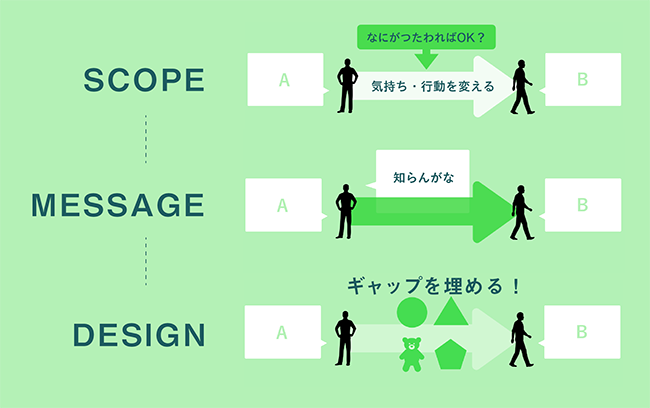
For inquiries, contact TANTEKI!
http://dentsutanteki.com/
Was this article helpful?
Newsletter registration is here
We select and publish important news every day
For inquiries about this article
Back Numbers
Author

Taichi Sayama
Dentsu Inc.
Creative Design Bureau
Art Director
Winner of numerous awards both domestically and internationally, including Cannes Lions, Spikes Asia, and the Grand Prix for Transportation Advertising. Possesses broad, diverse production experience spanning graphic design, video, CAD, and programming. Hobby is electronics tinkering.

